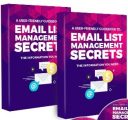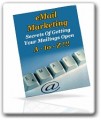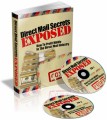Table of Contents
Introduction
Chapter 1: Identifying the Target Audience for Your Marketing Campaign
Chapter 2: Choosing the Perfect Email-Marketing Platform
Chapter 3: Decide on your list incentive
Chapter 4: Create and feature topnotch list incentives
Chapter 5: Choose Your Email – between Updates and Pre-Schedule Mails
Chapter 6: Optimize your list by targeting your traffic source
Chapter 7: Optimize Your Squeeze Page Sign-Up Rate
Chapter 8: List Segmentation Strategy – Identifying and Working on it
Conclusion
Sample Content Preview
Chapter 1: Identifying the Target Audience for Your Marketing Campaign
If you have a fuzzy idea of who your target audience is, you are going to fail with e-mail marketing. You really are. You might as well give up now if you are chasing after some sort of vaguely defined market.
Audience identification is crucial for niche list marketing. You cannot just target everybody. You have to drill down to a specific population of people who are trying to solve a fairly narrow set of problems. This is how you define their needs. By directly addressing the needs of these individuals, conducting enough consumer research and speaking their language, you would be able to convert a high percentage of them from website visitors to list members to product buyers.
It is crucial that you go from raw traffic to dollars in your bank account. Otherwise, you’re just wasting your time. All the traffic in the world is not going to add one red cent to your bank account unless you target a specific niche market and give its audience the solutions that they are looking for.
Finding the Right Audience
So, how do you know which audience you should target? There are many different audiences out there. All of them cluster around a specific range of needs or problems. Well, it all boils down to commercial value of those needs. There are many problems out there that people are not going to pay top dollar to solve. Sure, people are looking for the right DVD set of headphones but there is a limit to people’s budgets. Different problems have different priorities.
You need to find a niche that has enough commercial value. One way to estimate this is to use Google AdWords Keyword Planner and do cost-per-click research on keywords related to your niche. If you notice that advertisers are willing to pay a lot of money per click on those keywords, then you’re in a good spot. Chances are there is enough commercial demand for that niche. People are willing to pay a significant amount of money to solve problems related to your niche.
It’s also important to make sure that you are targeting a niche that is big enough. Sure, there are lots of advertisers willing to pay a tremendous amount of money for “structured settlement” keyword traffic. We’re talking about more than $20 per click. The problem is the volume of searches for that niche is actually quite low.
Make sure the niche you are targeting has enough demand as indicated by Google Keyword Planner. This tool not only tells you how much advertisers are willing to pay per click but it will also give you an estimate of the volume of searches for keywords related to that niche. You’re looking for a nice combination of decent commercial value with decent traffic volume.
Finally, you should also pay attention to competition levels. If you pick a niche that is extremely competitive with gigantic brands monopolizing pretty much all the search volume for keywords related to that niche, you probably are going to have a tough time making inroads. You should look for a niche that is somewhat competitive but no so competitive that there’s absolutely no space for newcomers.
How do you do competitive research? Very simple. Just get all the Google Keyword Planner tool keywords for the niches you are interested in. Plug them one by one into Google’s search box and you will see the number of pages competing for those keywords. This should give you a clear enough idea of how competitive certain niches are. At the end of this process, you should have a short list of niches that have decent commercial appeal and enough search volume every single month.
Consider these three factors:
Find Your Customers Online
I’ve got some great news for you. Regardless of the niche that you selected, chances are very high your customers are already online. You just need to find them. This doesn’t mean that there is a dedicated website that caters specifically to your niche audience. Instead, your niche audience members may simply be asking questions related to your niche. Maybe they’re sharing infographics or photos and videos related to your niche.
Whatever the case may be they’re already online exchanging content. Your job is to find all these areas online and listen to them. That’s the main key you need to do for consumer intelligence.
Pay attention to the words that they’re using. Pay attention to the solutions that they’re already talking about. Understand the shortcomings of the solutions people are already aware of.
If you spend enough time on these online platforms like forums, message boards, Facebook groups, Facebook pages, Twitter accounts, Reddit, subreddits and Quora or other question-and-answer platforms, you should have a clear understanding of who your audience members are and their expectations.
You should also have a fairly clear idea of who your competitors are. I’ve got some bad news for you. Regardless of your niche, you probably already have competitors. This is not depressing news. Instead, you could use this to your advantage. Find the competitors competing for your target audience. Create a long list of them. Look for both direct and indirect competitors.
Reverse Engineer Your Competitors
Once you have a clear idea of who your competitors are, reverse engineer what they’re doing. How do they speak to the needs of the people you’re trying to reach? What do their websites look like? What kind of social media accounts do they have? What kind of content do they use for marketing purposes? How are their pages designed? You have to keep these and other related questions in mind as you research one competitor after another.
After you’ve spent some time asking these questions and processing your competitors in a systematic and methodical way, you should have a clear idea of what your niche “industry standard” is. You would quickly find out that your niche competitors tend to look alike.
They tend to address the same problems. They tend to have the same solutions. Their social media accounts tend to look similar to each other.
Be mindful of this. Look at these similarities and understand that this is the “industry standard” in your niche. Whatever website or social media account or mailing list you come up with must fit the industry standard.
Please understand that when you figure out the industry standard in your niche, it just gives you a place to start. You shouldn’t start and end there. If anything, it just gives you a head start instead of fumbling around to come up with the right squeeze page or mailing list marketing materials for your niche. It gives you a place to start.
What “Industry Standard” Item Should You Look For
Pay attention to your competitor’s squeeze page layout. This is the signup page your competitors use to get their target audience members to sign up for their mailing list. Pay attention to how they lay out these pages.
What kind of pictures do they use? What kind of text do they present? How did they format their text? Do they tell stories? Do they show videos?
Next, pay attention to their sales funnel layout. Your competitors have a standard way of getting people to sign up to their mailing list and also selling those list members to a wide range of products and services. Be aware of how they do this. How do they step prospects through the sales process?
Understand that their ultimate goal is to get list members to buy something. Try to figure out how their sales funnel is laid out and how it seeks to convert list members. Pay attention to the kind of freebies or incentives your competitors give out to get people to sign up to their mailing list.
Do they use cheat sheets or short reports? Do they give away full books? Do they attract list members by offering a special video? Do they promise some sort of insider information that people have to sign up for to access?
Be aware of the specific “industry standard” digital incentive your competitors give out. You’re going to have to offer the same. You can tweak this later on, but you need to start out with this type of incentive.
Subsequently, pay attention to the updates that they send. Do they talk about news and events? Do they seek to teach e-mail recipients a wide range of solutions? Finally, pay attention to the stuff that they are promoting in their e-mails. You can bet that your competitors are sending out e-mails intended to make them money. If you click on the right link, it would lead you to a product they hope you would buy. The same goes with services.
Pay attention to these. Identify the most common products that they push with their updates. Again, this forms the “industry standard” in your niche. Look for the industry standard because this is where you will start. It doesn’t mean you have to start and end your e-mail list marketing activities with the industry standard. Instead, it just gives you a tremendous head start because you’re not fumbling around coming up with your own squeeze page and mailing list strategy which might fail. Instead, by going with the tried and proven industry standard, you can improve on mailing list practices that already exist. You just need to perfect whatever it is your competitors are already doing.
Chapter 2: Choosing the Perfect Email-Marketing Platform
This step is crucial. In fact, it’s so important that it only comes second in importance to Step #1. You have to have the right technology workhorse to ensure your mailing list business is a success. You have to understand that you cannot do e-mail marketing manually. It’s physically impossible. Even if you have a list of only 500 people, sending e-mail updates to those people one by one is going to drive you nuts.
You have to sign up to the right e-mail marketing platform that would automate all mail delivery. You might think that this is a pretty simple process. It isn’t. It’s very hard to manually keep tract of people signing up and unsubscribing to your list. You may be able to get away with it if you only have a handful of members, but once your mailing list starts to grow, it can easily get out of hand.
Pay attention to key common features of e-mail marketing platforms:
Automated Autoresponder Sequence
Regardless of the platform you go with, they must have a way of enabling you to schedule e-mails to send to each and every one of your list members on a scheduled basis.
For example, if somebody joined your list on Monday, they get the e-mail update for Day 1. On Tuesday, they get the e-mail update for Day 2. When another person signs up for your mailing list on Friday, they get Day 1’s update and so on and so forth.
In other words, your mailing list platform must be automated and powerful enough to market to all your list members on an individually scheduled basis. This is crucial if you want to use your autoresponder e-mail sequence to turn your list members into buyers.
Other Details- 1 Ebook (PDF, DOC), 43 Pages
- 4 Ecovers (PSD, JPG, PNG)
- Year Released/Circulated: 2021
- File Size: 24,190 KB
License Details:
[YES] Can be sold
[YES] Can be used for personal use
[YES] Can be packaged with other products
[YES] Can modify/change the sales letter
[YES] Can modify/change the main product
[YES] Can modify/change the graphics and ecover
[YES] Can be added into paid membership websites
[YES] Can put your name on the sales letter
[YES] Can be offered as a bonus
[YES] Can be used to build a list (giveaway against an email)
[YES] Can print/publish offline
[YES] Can convey and sell Personal Use Rights
[YES] Can convey and sell Resale Rights
[YES] Can convey and sell Master Resale Rights
[YES] Can convey and sell Private Label Rights
[NO] Can be given away for free
[NO] Can be added to free membership websites














